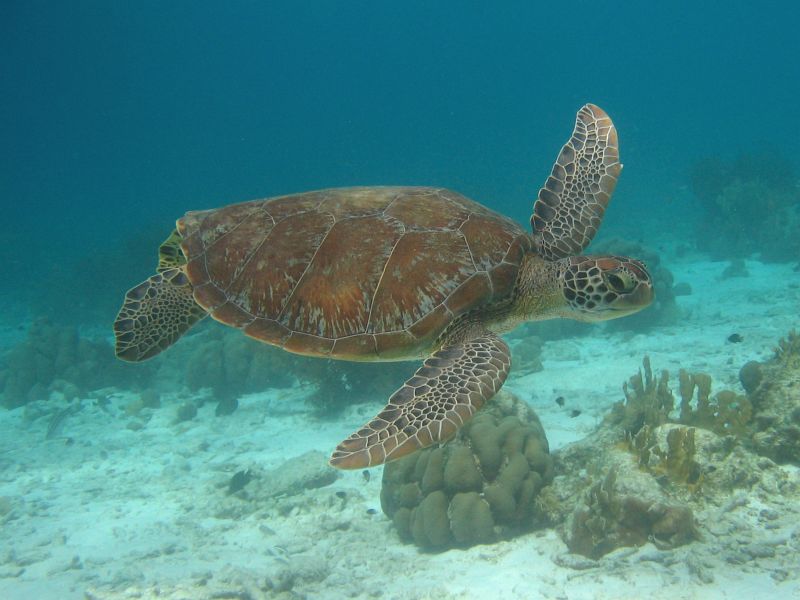How do sea turtles hear?

Olive ridley sea turtle nesting on a beach in Guatemala. Photo courtesy of Scott Handy, Pacuare Reserve, Costa Rica.
Sea turtles are found throughout the ocean, except in cold, polar waters. At present, we do not have any reliable underwater recordings of sounds produced by turtles, nor do we know how well most sea turtle species hear sound either in air or underwater.
Like all turtles, sea turtles lay eggs on land. Mating takes place at sea, but female sea turtles must come onshore to lay their eggs. Most females go back to the same beach each year, usually returning to natal beaches where they were hatched themselves. Sea turtle nesting is the only period during which sea turtle vocalization has been documented (turtles are considered the least vocal of all living reptiles). The process is physically exhausting, and sounds generated by the sea turtle are a result of breathing, pumping sounds from the turtle’s throat, and grunting. The eggs incubate in nests in the sand for roughly two months, after which they hatch en masse, usually at night, and the hatchlings will then make their way to the ocean. There is evidence that light plays a role in their ability to locate the ocean, however it is uncertain if other sensory cues also play a role.
Our best data regarding sea turtle hearing come from studies using auditory brainstem responses (ABRs). From this work, scientists do know that sea turtles can hear low to mid-frequency sounds, but with poorer sensitivity than mammals.

Audiograms for the green turtle (Chelonia mydas; Cm), kemp’s ridley turtle (Lepidochelys kempi; Lk), and the loggerhead turtle (Caretta caretta; Cc). Audiograms are determined from Auditory Brainstem Responses (ABRs). Turtles do not hear well above 1,000 Hz or below 100Hz. Most sea turtles hear best between 200 and 700 Hz depending on the species and age of the turtle. From Ketten and Bartol (2005).
Sea turtles appear to hear best between 200 and 750 Hz and do not respond well to sounds above 1,000 Hz. To determine the hearing capabilities in an adult green sea turtle (Chelonia mydas), researchers obtained a behavioral audiogram for an older female green sea turtle, “Myrtle”, housed in the New England Aquarium’s Giant Tank exhibit. Based on her responses, it was concluded adult green sea turtles hear best between 200Hz-500Hz.
The opening into a sea turtle’s ear is covered by thick skin, known as the cutaneous plate, which is a ring of scales that are similar but smaller than those on the rest of the head. Below this skin is a fatty (subcutaneous) layer. The thick skin and a fatty layer make it difficult for the turtle to hear well in air, but provide good tissue conduction for underwater sound to the middle ear and inner ear.

The auditory mechanism for the Green Sea Turtle (Chelonia mydas) showing the thick outer skin and fatty under-layer. From Ridgway et. al (1969).
Most scientists recognize seven sea turtle species: the green turtle (Chelonia mydas), flatback (Natator depressus), loggerhead (Caretta caretta), hawksbill (Eretmochelys imbricate), olive ridley (Lepidochelys olivacea), Kemp’s ridley (Lepidochelys kempi) and leatherback (Dermochelys coriacea). Six of these species can be found in U.S. waters (green, loggerhead, hawksbill, olive ridley, Kemp’s ridley, and leatherback), and all are listed as either threatened or endangered under the Endangered Species Act.

The green sea turtle, Chelonia mydas . Photo courtesy of R.P. Van Dam.
Additional Resources
- University of North Carolina (Chapel Hill), Orientation and Navigation of Sea Turtles.
- Woods Hole Oceanographic Institution Computerized Scanning and Imaging Facility, Sample Images and Movies.
- U.S. Fish & Wildlife Service, North Florida Field Office, Sea Turtle Information.
References
- Bartol, S. M., Musick, J. A., & Lenhardt, M. L. (1999). Auditory Evoked Potentials of the Loggerhead Sea Turtle (Caretta caretta). Copeia, 1999(3), 836. https://doi.org/10.2307/1447625
- Cook, S. L., & Forrest, T. G. (2005). Sounds produced by nesting leatherback sea turtles (Dermochelys coriacea). Herpetological Review, 36(4), 387–390.
- Ketten, D. R., & Bartol, S. M. (2005). Functional Measures of Sea Turtle Hearing. Woods Hole Oceanographic Institution: ONR Award No: N00014-02-1-0510.
- Lenhardt, M., Moein, S., & Musick, J. (1996). A Method for Determining Hearing Thresholds in Marine Turtles (Proceedings of the Fifteenth Annual Workshop on Sea Turtle Biology and Conservation, NOAA Technical Memorandum NMFS-SEFSC-387).
- Luschi, P., Åkesson, S., Broderick, A., Glen, F., Godley, B., Papi, F., & Hays, G. (2001). Testing the navigational abilities of ocean migrants: displacement experiments on green sea turtles (Chelonia mydas). Behavioral Ecology and Sociobiology, 50(6), 528–534. https://doi.org/10.1007/s002650100396
- Lutz, P. L., Musick, J. A., & Wyneken, J. (Eds.). (1996). The biology of sea turtles. Boca Raton, Fla: CRC Press.
- National Research Council. (1990). Decline of the Sea Turtles; Causes and Prevention. Washington, D.C.: The National Academies Press.
- O’Hara, J., & Wilcox, J. R. (1990). Avoidance responses of loggerhead turtles, Caretta caretta, to low frequency sound. Copeia, 1990(2), 564. https://doi.org/10.2307/1446362
- Ridgway, S. H., Wever, E. G., McCormick, J. G., Palin, J., & Anderson, J. H. (1969). Hearing in the giant sea turtle, Chelonia mydas. Proceedings of the National Academy of Sciences, 64(3), 884–890.
- Samuel, Y., Morreale, S. J., Clark, C. W., Greene, C. H., & Richmond, M. E. (2005). Underwater, low-frequency noise in a coastal sea turtle habitat. The Journal of the Acoustical Society of America, 117(3), 1465–1472. https://doi.org/10.1121/1.1847993